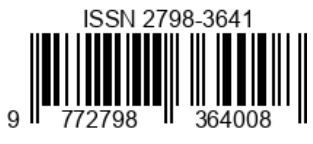ISOLASI & IDENTIFIKASI ALFA SELULOSA DARI KULIT BUAH LIMPASU (BACCAUREA LANCEOLATA) SEBAGAI ALTERNATIF BAHAN BAKU PEMBUATAN MIKROKRISTALIN SELULOSA DARI BAHAN ALAM
DOI:
https://doi.org/10.53625/jirk.v3i5.6701Keywords:
Alpha Cellulose, Baccauera Lanceolata, Cellulose, LimpasuAbstract
The diversity of natural resources in Indonesia, which is very abundant, will directly correlate with chemical diversity which has enormous potential for drug development. Indonesia needs to develop the pharmaceutical industry, especially drug raw materials, thereby making drug prices cheaper. The best solution to this problem is to continuously look for alternatives from Indonesian natural materials, so that the manufacturing process can be carried out both on a laboratory and industrial scale. There are many fruits typical of South Kalimantan and not available in other areas, one of which is Limpasu. This research aims to determine the cellulose content in Limpasu (Baccaurea lanceolata) fruit peel waste using the chemical delignification method. Proving the use of this plant is very important, so that the residue resulting from extraction from the Limpasu fructus cortex can be utilized into a very useful preparation. The research was carried out by first extracting simplicia from the plant, then the remaining residue from the extraction was continued to the alpha cellulose isolation stage. Based on the results of research that has been carried out, it was found that the pure cellulose content in the form of alpha cellulose contained in the Limpasu fructus cortex is 21.08%. These results prove that Limpasu fruit peel has the potential to be used as a source of natural raw materials for the manufacture of other cellulose derivative products that can be used in pharmaceutical formulations.
References
Angga, D. 2018. 90% Bahan Obat Impor, Pemerintah Genjot Investasi Bidang Farmasi. Available at https://ekbis.sindonews.com/read/1285738/34/90-bahan-obat-impor-pemerintah-genjot-investasi-bidang-farmasi-1519791594. [Diakses pada 10 Agustus 2023].
Bakar, A., Ahmad, N.E., Karim, F.A., & Saib, S. 2014. Phytochemicals and antioxidative properties of borneo indigenous liposu (Baccaurea lanceolata (Miq.) Müll.Arg.) and tampoi (Baccaurea macrocarpa) fruits. Antioxidants; 3: 516-525.
Chowdhury, S.G., Chanda, J., Ghosh, S., Pal, A., Ghosh, P., Bhattacharyya, S.K., Mukhopadhyay, R., Banerjee, S.S., Das, A. 2021. Morphology and Physico‐Mechanical Threshold of α‐Cellulose as Filler in an E‐SBR Composite. Molecules; 26: 1-17. https://doi.org/10.3390/molecules26030694.
Hikmah, N. & Gunawan. 2022. Etnobotani Kapul (Baccaurea macrocarpa) dan Limpasu (Baccaurea lanceolata) Oleh Suku Dayak dan Suku Banjar Di Kabupaten Hulu Sungai Selatan dan Hulu Sungai Tengah. Bioscientiae; 19(2): 103-109.
Kemenkes RI, 2013, Riset Kesehatan Dasar; RISKESDAS, Balitbang Kemenkes RI, Jakarta.
Kemendikbud RI. 2018. Alamku Berlimpah. Jakarta: Kemendikbud RI.
Lestari, Y.P.I., Falya, Y., Chasanah, U., Kusumo, D.W., & Bethasari, M. 2022. Isolasi α-Selulosa, Pembuatan & Karakterisasi Mikrokristalin Selulosa (MCC) Dari Limbah Kulit Jeruk Baby (Citrus sinensis). Majalah Farmasi dan Farmakologi; 26(3):119-123.
Mulyadi, I. 2019. Isolasi dan Karakterisasi Selulosa : Review. Jurnal Saintika UNPAM; 1(2):177-182.
Nawangsari, D. 2019. Isolasi dan Karakterisasi Selulosa Mikrokristal dari Ampas Tebu (Saccharum officinarum L.). Pharmacon: Jurnal Farmasi Indonesia. 16(2): 67-72.
Pine, A.T.D., Base, N.H., & Angelina, J.B. 2021. Produksi Dan Karakterisasi Serbuk Selulosa dari Batang Pisang (Musa paradisiaca L.). Jurnal Kesehatan Yamasi Makassar; 5(2): 115-120.
Rowell, R.M. 2005. Chemical modification of wood. Handbook of wood chemistry and wood composites. Boca Raton, Fla: CRC Press. 381-420.
Sari, D.P., Padil, & Yelmida. 2014. Pemurnian Selulosa-α Hasil Hidrolisis Pelepah Sawit Menggunakan Enzim Xylanase dengan Variasi PH dan Sumber Enzim Xylanase. Jurnal Online Mahasiswa Fakultas Teknik Universitas Riau.
Sumada, K., Puspita E. T., dan F. Alqani. 2011. Kajian Proses Isolasi α-selulosa dari Limbah Batang Tanaman Manihot Esculenta Crantz yang Efisien. Jurnal Teknik Kimia; 5(2): 434.
Syam, L.K., Farikha J., Fitriana, & Dian N. 2009. Pemanfaatan Limbah Pod Kakao Untuk Menghasilkan Etanol Sebagai Sumber Energi Terbarukan. Tersedia di: http://repository.ipb.ac.id/handle/1234567 89/20208 [Diakses pada tanggal 22 Agustus 2023].
Syamsul, E. S., Anugerah, O., & Supriningrum, R. 2020. Penetapan Rendemen Ekstrak Daun Jambu Mawar (Syzygium jambos L. Alston) Berdasarkan Variasi Konsentrasi Etanol dengan Metode Maserasi. Jurnal Riset Kefarmasian Indonesia; 2(3).
Wijaya, D., Yanti, P. P., A, R. S., Rizal, M. & A, R. S. 2015. Screening Fitokimia dan Aktivitas Antioksidan Daun Eceng Gondok (Eichhornia crassipes). JKV: 65–69 (2015) doi:10.15408/jkv.v0i0.4965
Zamzani, I., & Triadisti, N. 2021. Limpasu Pericarpium : an Alternative Source of Antioxidant From Borneo with Sequential Maceration Method. Jurnal Profesi Medika : Jurnal Kedokteran dan Kesehatan, 15(1). https://doi.org/10.33533/jpm.v15i1.2820.













